#bríg
Explore tagged Tumblr posts
Text
Why dandelions grow (abridged)/ As beárnan gidge raired
an Irish Traveller story

The old ones say that during the great flood, the Mincéirí, in fear, had prayed and willed away the clouds, so there came a great drought when the sun shone ceaselessly and no rain fell, when the skies themselves were emptied and the sun stood fixed in place as their ruler.
At first the skies had resisted the banishing of the clouds, understanding the cycle of the weather and how it has its mark on the passing of each day, but so great was the fear of the great flood that nature herself withdrew the clouds and the rain for the sake of the Mincéirí.
In the beginning, the dry days and crisp nights brought only joy, the warm sweet morning air woke people with a softness and the evenings often saw children playing by streams and ponds. The old would rest under the shade of the hazel trees and songs were the common company of the slow-moving winds.
As time went on, however, people grew weary, dreary, dusty and dry. Animals became ill, plants started to shrivel and even the birds refused the winds, preferring to walk on the earth in search of what food remained.
The drought continued until one day a beautiful young lackeen named Brid called to the sun in search of an answer. She knew the land. She knew the plants, the trees, the weary rivers and how the fiery sun was slowly quenching the flames of those she loved. But the sun, the sun did not reply.
. . . .
The young girl, distraught, fell to the ground and cried, So great were her wails of loss that the star and the moon looked upon her and wept. The sun, on hearing their cries, finally turned towards Bríd. The young lackeen, in desperation and tiredness, but with a depth of wit and a strength rare in a child of her age, pleaded with the sun to rest. She spoke of life with its relentless presence, of the cracking lands and withering animals, of the river beds that looked like deep, carved scars upon the soil, of red sun-flamed flesh and world that knew so much disorder. She spoke of the need for rhythm, of the folly of her people who in fear had driven away the natural movement of the sun.
The sun spoke in a booming voice, loud enough to shake the crumpled leaves that remained on the trees and for the cracked soil to give up a thick layer of dust as if the land itself was breathing. The sun explained that it was the people who had banished the clouds, who had implored it to shine without resting, so on it would shine.
Her body exhausted from the trials of her journey and her spirit as brittle as the withered leaves, this last denial was a wound she could not recover from. With a whimper, she fell back against the ground, and there the young lackeen died.
The sun looked down on her broken frame and was stirred in a great sorrow for her, for her journey, for her half-lived life, and for her death. It shed tears that fell and mixed with the tears of the star and the moon, who too did mourn for her. Their tears fell to the earth and sank deep into the thirsty soil.
Knowing their part in what had happened, the sun, star and moon gathered in the sky. Each promised the young lackeen that they would never forget her.
Eventually from those fallen tears grew a plant, blessed in the light of the sun, star and moon, and took unto it their shapes and forms.
Among its many names is dandelion.
Even to this day, the dandelion remains embodied with the fiery force of the sun, moon and star and it grants the easy flow of water to those who drink it in a tea. If you look closely at the dandelion you will see that it resembles the sun when it is in flower, the moon when it is in seed, and the star is in the leaves that grow about its base. If you are lucky and pick it carefully from the ground with a song, you might find that the roots are in the form of the young lackeen.
To read the entirety of this story, and many others, check out Why the moon travels by Oein DeBhairduin
#I dont know if this story qualifies as a link between Bríd and the sun#theres also an interesting western star reference in there#read the fully story!!!!! its absolutely beautiful and a much longer journey with beautiful metaphors#this book is generally a must-read for anyone interested in#Irish folklore#ofc it is#but definitely related#and more support absolutely should go to Oein DeBhairduin and the Mincéirí#i hoped trsnscribed part of this story is a good teaser to get people interested in the book#and generally with#Irish Traveller folklore#(<thats the missing tag before)#Irish Travellers#the Mincéirí#the Pavee#an lucht siúil#request this book through your library!!!#ESPECIALLY if you live in ireland#Bríd#Brighid#Bríg#Luis#Lus#very big leap - could this even somehow tie into the story of the an Dagda and Boann?#not only the obvious but also Bríd is an Dagda's daughter and some have speculated the twin of Aengus#though thats not necessary for this#herbalism#i love how many of the stories are explaining herbal uses
14 notes
·
View notes
Text
So as far as I'm aware in the Celtic umbrella of deities we don't have any deities SPECIFICALLY related to weaving/textiles or pottery. Which in the grand pattern of Indo-European branches (or even humanity as a whole) seems.... very odd...
What are the community's thoughts on these acts falling under the purview of Brigit or her other language counter parts? Are there other deities that would make more sense for these activities? What are our thoughts?
#gaelpol#gaelic paganism#gaelic polytheism#gaelic deities#celtic#celtic paganism#celtic polytheism#celtic deities#Irish#irish paganism#irish polytheism#irish deities#gaulish#gaulish polytheism#Gaulish paganism#Gaulish deities#brigid#brighid#brigit#bríg#bríd#*Brigantī#Brigantia#Brigindo
76 notes
·
View notes
Text

The hearth altar as I go to bed on Bride’s Eve
2 notes
·
View notes
Link
“It is flattering when people are drawn to one of my paintings without knowing the mythology that influences it. By far, this painting is the one I have been asked to talk about the most. ‘What is this about?’ Or often ‘What the hell is going on here?’
“The short answer: This painting is my veneration of art itself. I can not express in words the ways that artistic work gives my life meaning, and the act of creation and creative flow is the state of existence that I strive to be in daily. It is the closest I personally feel to sublimity.”
I love this painting and have it at my personal home shrine. Here’s the artist’s discussion of what it meant to her to create it.
#Brighid#Brigid#Brigit#Bride#Bríd#Valerie Herron#art#paintings#devotional art#the act of creation#bríg#creative energy#She is here
1 note
·
View note
Text
Imbolc / Lammas Day and Goddess Bríg
“Brigid, the Celtic goddess of fire (the forge and the hearth), poetry, healing, childbirth, and unity, is celebrated in many European countries. She is known by many names, including that of Saint Brigid, who is, perhaps, the most powerful religious figure in Irish history.”

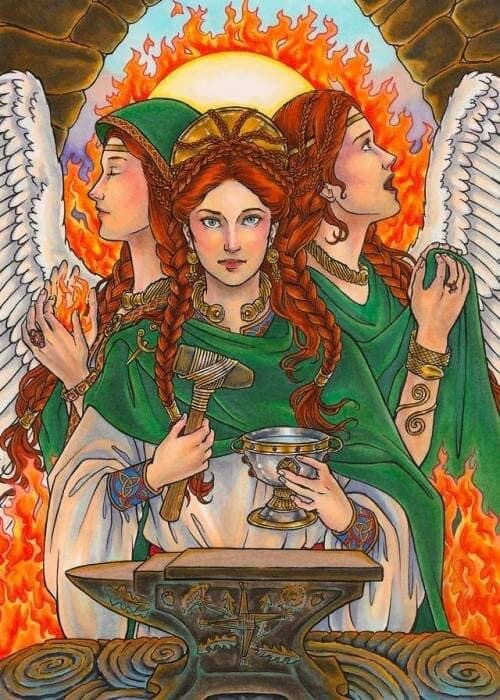
1 note
·
View note
Text

When I come up in the club— I'm talking mad shit! Come up in the club, I'm 'bout to get my ass kicked!
Here's #3 from @mushroom-soup-cat's Magic Prompts list. I have listened to PUNKBITCH about a billion times, ever since I was a wee queer... Nothing more fitting for Bríggums.
#ocs#original characters#bríg trudeau#brig trudeau#original content#ART TAG#MACK TAG#drawtober#artober#magic prompts 2024#THIS one is probably my favorite so far because i love the idea of bríg beating the shit outta people in the club#even if what actually happened was some dignitary or whatever's kid talked mad shit FIRST#and now it's just personal#ESPerverse.
10 notes
·
View notes
Text
Bríg keeps sending me the most amazing signs ❤️
1 note
·
View note
Text
I wrote a post trying to figure out why on earth some Pagans & Witches refer to Imbolc (an Irish spring agricultural holiday associated with St Brigid, a potential Christianization of the Goddess Brigid/Bríg) as Candlemas, the completely Christian holiday celebrating The Purification of Mary & Presentation of Jesus at The Temple— which originated in the eastern part of the Roman Empire (which the only "pagan" aspect was it competing with Roman Lupercalia for celebrants).
Many pagan & witch spaces online have a constant disdain for Christianity thus I could not wrap my head around them using such an important point of Jesus' & Mary's life as one of their festivals/'sabbats'.... then, after writing a bunch of stuff, I stumbled onto the answer on Wikipedia's Wheel of The Year page, which has citations for its claims:
Margaret Murray (very early 20th century scholar) in her now discredited witch-cult hypothesis said that the Scottish "witch" Issobell Smyth in 1661 confessed to attending meetings for witches on the cross quarter days included Candlemas. Robert Graves (oh how I loathe you ehem I mean: poet folklorist), mentioned that Candlemas was part of the 8 ancient British agricultural festivals. And Doreen Valiente ("The Mother of Wicca") included Candlemas in her list of Greater Sabbat Fire Festivals, while also listing "Gaelic counterparts," in this case Imbolc.
Sigh.
Early (read: 19th-20th century) paganism and witchcraft, or scholarly work about it, really was just: put every claim regardless of accuracy from any culture in this jar, shake it up real good, see what pops out from the mix, then pretend its historically attested to and traditional despite any and all evidence.
Also whatever Wikipedia writer wrote this, I appreciate your sassiness ... even if it was unintentional:
Due to early Wicca's influence on modern paganism and the syncretic adoption of Anglo-Saxon and Celtic motifs, the most commonly used English festival names for the Wheel of the Year tend to be the Celtic ones introduced by Gardner and the mostly Germanic-derived names introduced by Kelly, regardless whether the celebrations are based on those cultures.
EDIT: To be clear, not all neo/pagans, witches, wiccans, occultists, people-who-use-wheel-of-year are anti-Christian! I'm not trying to say that. But as a worshipper of Mary now, I notice it more and more. Nor am I saying all those people follow Murray/Grave/Valiente blindly but published works and trusted blogs often seem to. This is simply an observation, I've taken notice of, its not the entire communities.
#wheel of the year#imbolc#imbolg#candlemas#pagan#neo pagan#polytheist#witch#annoying history#theres a great post on the actual irish holidays from ya know an irish perspective#but i cant find it#holiday#mariolatry#first sorrow#deletes previous draft#should have just read wheel of year article first#letsdebunk#tag seems appropriate i guess
44 notes
·
View notes
Text
Mythology Olympics tournament round 1
Propaganda!
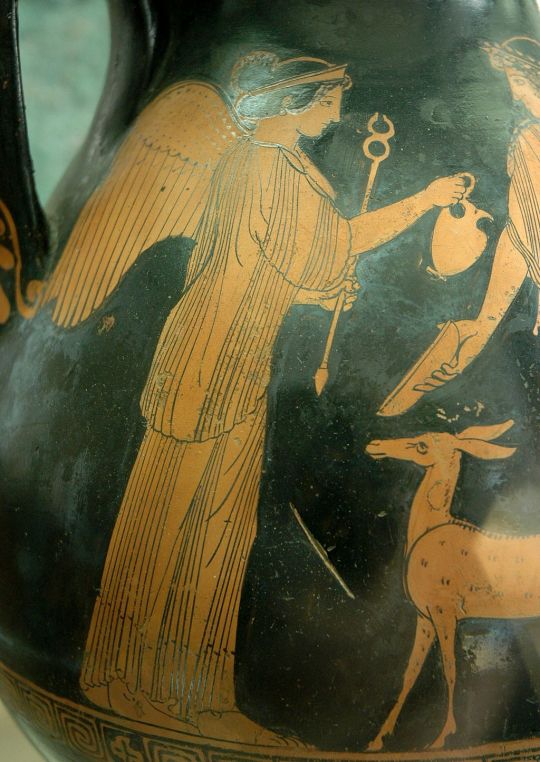
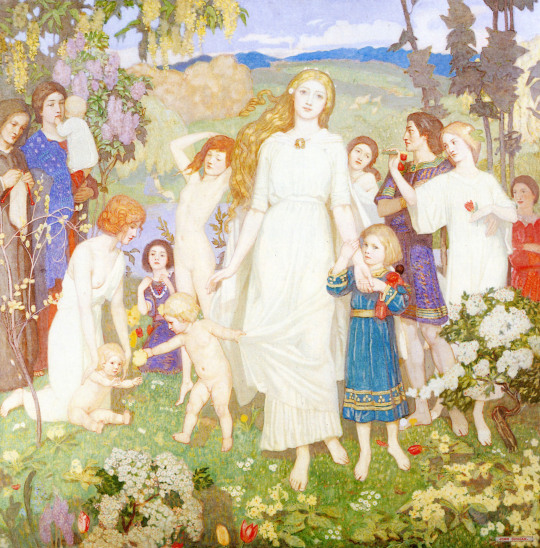
In ancient Greek religion and mythology, Iris is a daughter of the gods Thaumas and Electra, the personification of the rainbow and messenger of the gods, a servant to the Olympians and especially Queen Hera. Iris appears in several stories carrying messages from and to the gods or running errands but has no unique mythology of her own. Similarly, very little to none of a historical cult and worship of Iris is attested in surviving records, with only a few traces surviving from the island of Delos. In ancient art, Iris is depicted as a winged young woman carrying a caduceus, the symbol of the messengers, and a pitcher of water for the gods.
Brigid or Brigit (Irish: [ˈbʲɾʲiːdʲ]; meaning 'exalted one'), also Bríg, is a goddess of pre-Christian Ireland. She appears in Irish mythology as a member of the Tuatha Dé Danann, the daughter of the Dagda and wife of Bres, with whom she had a son named Ruadán. Her sacred tree appears to have been the birch, given some older Imbolc-related traditions. She is associated with wisdom, poetry, healing, protection, smithing and domesticated animals. Cormac's Glossary, written in the 9th century by Christian monks, says that Brigid was "the goddess whom poets adored" and that she had two sisters: Brigid the healer and Brigid the smith. This suggests she may have been a triple deity.
#iris#greek mythology#greek#greece#brigid#irish mythology#irish#ireland#poll#polls#tumblr poll#tumblr polls#tournament poll#mythology#mythology tournament#wikipedia
11 notes
·
View notes
Text
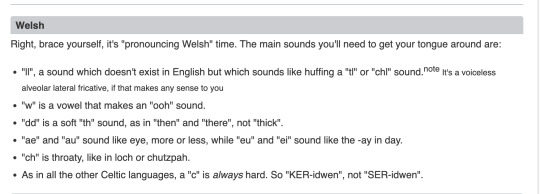
I love how the Celtic Mythology TV Tropes page went from "Relatively accurate (after I worked hard to revise it)" to "Filled with disinformation thanks to a couple of overly active users + cracks about the pronunciation system (that aren't even accurate)"
...they were saying that "Bres" should be pronounced "Bresh."
...There is a reason why "Bres" is spelled "Breas" in modern Irish -- that is a BROAD "es", not a palatal, the palatal "s" sound "sh" does NOT apply.

It's. It's "Brigit." The name. "Brigit." She is usually called. "Brigit." In pretty much all medieval sources. Or "Bríg." Neither of which. Is...

He. He isn't confused with Eber Donn. He IS Eber Donn. Where are you getting this stuff? Where is he the son of the Dagda? Were you actually high when you wrote this?

Is the Dagda. Kind. Is he really? Or is that a headcanon to fit a specific image. Of the Dagda? (Who, in at least one story, requires multiple TWs for what he allows one of his sons to do?)

We have literally as much evidence for Tethra and Manannán being boyfriends as we have for them being on opposite ends of the war, aka none. Assuming that they're on opposite ends of the war assumes that Manannán gives a single flying fuck about the war in the first place.
Nodens is put alongside the Tuatha Dé.

Is Danu. Any of these things. Is she? (This is after I had to remove a reference to Peter Beresford Ellis' bogus "creation myth.") The previous entry discussed her ambiguity as a figure/the very real possiblity that she was never WORSHIPPED as a deity.
Not shown: The entry on Cernunnos, which said he was worshipped in IRELAND.
The entry for Branwen, that claims that she's a Welsh love goddess (?) (There is not much love in her story.) (I would not even say there is much lust.)

"Because he is a cunt."
(Is he unique? Is he really? Because there are a LOT of hot Fomoire when you think about it.) (Also...where is Elatha's sense of humor? It is non-existent.)

Really. Is that why Conchobar does it? Is that really why he does it?

Unless it is not out of character (otherwise there are a LOT of Out Of Character Conchobars) so much as a different writer (likely from Connacht) having a different take on a complex character with a complex legacy. (Who is established in the Táin as being pretty useless, tbh.) (Like, where are these "in character" Conchobars that you speak of?)

...that. Is not. How you pronounce "Fionn" with that spelling. (It's "fee-on.")

Is that what happened? I just, I just don't remember. My memory of Cath Maige Tuired is so weak that the bit where the TDD elected Bres for his beauty slipped my mind. Could anyone pull up that bit for me? Along with the bit where he helped the Fomoire invade Ireland while he was king? I just, I don't know, I'm new to this, and the language is so arcane, so obscure, I just don't remember it.
#long post#i'm tempted to assign it as extra credit to my students#'if you can prove that you made one positive edit to this page'#'i will give you bonus points'
25 notes
·
View notes
Text
Beannachtaí na Féile Brídhe oraibh!
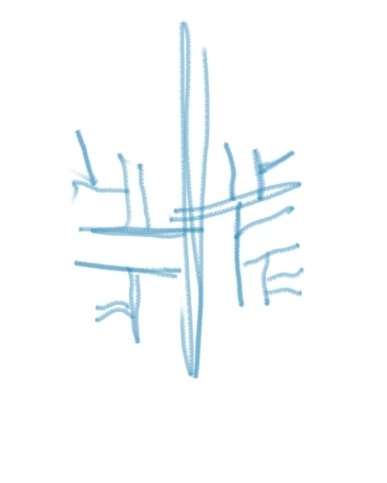
Cros Brídhe made of Beithe agus Luis
quick little rúnogham that popped up into my head as I fell asleep
2 notes
·
View notes
Note
Hello! I'm having trouble coming up with devotional acts for the goddess Brigid. Can you offer any suggestions?
Thank you!
Hmmm. Well I've never worked with Brigid myself, and therefore may not be the BEST person to ask, she's always struck me as a very kindly deity. I imagine something as simple as tending to a plant or volunteering your time would be things she would appreciate as devotional acts. But if you're craft at all (not good at them necessarily, but have some kind of craft you enjoy doing) you could also try working on said craft with then intention of 'sitting' with her.
I know MANY people link her to fire (though this could have been more specifically to do with Saint Brigid) so tending a small fire or lighting a special candle for her could also being a good activity.
3 notes
·
View notes
Text

Imbolc Preparations
If I don’t start preparations a couple of weeks before, it never gets done on time. Managed to set up the altar this weekend
7 notes
·
View notes
Text

@too-fond-to-be-fearful @moonlarking
Okay, so Fomoire Drama Time --
Generally, with criticism of CMT, we say that you have about three generations represented in the text -- there's the older members of the Tuatha Dé (the Dagda, Ogma, Nuadu), a middle generation (Míach, Airmed, Bres, Óengus), and a younger, up and coming generation (Lug). Lug is born during Bres' reign, but Bres is still a generation behind people like the Dagda. (And yeah, you'll notice how screwed and tragic Bres' generation is, sharing it with Míach.) (In headcanon territory, I also like to think that Bres is of an age with Étaín, even if she doesn't show up here.)
We have less on the Fomoire, so this is not me speaking as an Academic, it's me pointing out different strands and what I make of them on an informal level. You have older members of the Fomoire -- Balor, Indech, Elatha, and Tethra seem to be the hard hitters, since they're the ones who are invading Ireland during Bres' reign. Indech and Elatha are both described as kings of the Fomoire, and Balor is old enough to have a daughter of marriageable age when the TDD invade Ireland. Therefore, as two young adults at about the same time, Ethniu is likely of an age, roughly, with Bres, the two cousins are both part of that middle generation. (And then her son makes Bres' life a living Hell.)
But then we see this...sort of shadow generation that you catch glimpses of in the actual battle. Balor's twelve sons, who don't do all that much. The sons of Tethra, who are more useful of Tochmarc Emire.
Bres' son, Ruadán, who is described as being a man but, by all the laws of mathematics, he couldn't have been more than 30 when he died, and I'd honestly wager for early twenties as far as age. And the text specifies that, when he dies, he dies "in the presence of his father." We focus a lot on Bríg in this scene, understandably given it's a very poignant scene and really shows the cost of this conflict on the mothers, but no one ever points out that *he died in BRES' PRESENCE.* When I really want to hurt myself, I like to think about what "in his presence" meant. Did he collapse at Bres' feet? Did Bres hold him when he died? Did he collapse a little bit further away, so Bres only just missed being able to hold his son one last time? Was he too shocked to do anything? Bres isn't given any other children by the text, even though we see him with other children in other texts. There's one Dindshenchas text, the Dindshenchas of Bréfne, which gives Bres a daughter, Indusa/Innus, who dies via a deed of "manly might", in a tract that mentions Balor's army. Did she die fighting for...or against the Fomoire? Or did she die in a separate conflict? Either way, it wasn't natural. In that same tract, Bres is called "búain" -- "lasting, enduring; constant, firm, persevering." In the Dindshenchas of Cairn huí Néit, Bres is described as having died "without prosperous issue." I'm not saying that the implication in all three texts is that Bres outlived any and all children that he had, but I think that's a reading you could make. And this is AFTER his father demonstrated, very clearly, that he was kind of embarrassed by him and really pulling away from him, adding another layer of disfunction to the mix.
And then you have whatever the Hell's going on with Indech's line. Specifically, his daughter. She isn't given a name. She's always "Indech's daughter", she's described as being strikingly beautiful, and she has sex with the Dagda. She leaves the Fomoire for the Tuatha Dé. She's not really discussed all that often, but I have a lot of thoughts about her. (No, really, ask me about my thoughts on her and specifically how I'm interested in adapting her.) She and Ethniu are both Fomorian women who go to the Tuatha Dé, one as part of an arranged marriage, the other because the sex was great. I sometimes wonder how she fared after everything, as a foreigner whose father was one of the invaders. Did she form an alliance with the other Fomoire who were there? Did she mourn her father's death? Did she not care? Regardless, she's remarkably proactive, strong-willed, and sharp in the one scene we get of her.
His son Ochtriallach only gets a couple of lines but HE'S weird as well, more to come on that. He doesn't die, but he does pop up a little bit -- he fights and kills two of the Tuatha Dé's poets and is the one who orders the Tuatha Dé's healing wells to be stopped after Ruadán's death. Which. I can understand why some retellings make it so that it's Bres who gives that order, because it's WEIRD. It isn't said to be explicitly in response to Ruadán's death, but it's put so closely next to it that it's hard not to draw a connection. (Yes...I headcanon the two of them as lovers. OBVIOUSLY not present in the original text, I'm not claiming it is, but we know I'm always trying to make CMT gayer. I also headcanon the Daughter of Indech and Indusa as being girlfriends, because apparently Indech's line has a Thing for Bres'.)
And then we have Duirgen. Who does not appear in CMT, but in a later Dindshenchas tract, where we learn that she found out her mother was having sex with a slave instead of her father, told her father, and in vengeance, her mother told Indech, who was a kinsman of hers, to take revenge on Duirgen. He propositioned Duirgen, who fought back, and he finally killed her. I think about her more than I probably should given that she's a character who appears so briefly. That Indech actually tried to have sex with this girl whose mother is at least a kinswoman of his, who, by all implications, seems to be much younger than him. That she was just...tossed aside like that. The way her story links up with that unnamed daughter's, as both of them are kinswomen of Indech who defy him.
The point is that we don't get much on the younger generation of the Fomoire, I wouldn't argue the point TOO strongly, but I think it's very possible to make a reading that says that the Fomoire were portrayed, both in this text and in some of the later texts, as falling apart at the seams, and I think about them very much in the mode of Greek tragedy (that's not INCLUDING Balor's story, since that's another example of Fomorian Family Drama). The Tuatha Dé are going to eventually (and in the early modern recension, they ARE), but at least they have a Lug. At least they have an Óengus. Or an Airmed. Relationships between parents and children among the TDD are strained, but they EXIST, whereas with the Fomoire...it feels like this generation (and the slightly older generation) is being eaten alive. They don't have a Lug, they don't have a future. They are going to be utterly destroyed, either in exile (voluntary or not), dead from the war, or the victims of their own family members.
14 notes
·
View notes
Text

Exploring the Enchanting Realm of Brigid: Celtic Goddess of Fire and Wisdom
In the pantheon of Celtic deities, one goddess stands out with her multifaceted nature and captivating presence—Brigid. Often hailed as the Triple Goddess, Brigid embodies the realms of fire, poetry, and healing, weaving a rich tapestry of significance in Celtic mythology.
The Triple Goddess:
Brigid's trinity nature manifests in various aspects:
1. **Goddess of Fire:** Brigid is closely associated with the element of fire, symbolizing its transformative and purifying qualities. Fires were lit in her honor during festivals, and she was invoked for protection against destructive blazes.
2. **Goddess of Poetry and Inspiration:** Brigid is a muse to poets and bards, inspiring creativity and eloquence. Her influence extends to the written and spoken word, and she is revered as the patroness of the arts, encouraging the pursuit of knowledge and expression.
3. **Goddess of Healing and Fertility:** Brigid's healing touch extends to both the physical and spiritual realms. As a guardian of wells and springs, her association with water links her to the rejuvenating aspects of healing. Additionally, she is connected to fertility and abundance, fostering growth and prosperity.
Celebrating Imbolc:
One of the most prominent festivals dedicated to Brigid is Imbolc, celebrated around the beginning of February. Imbolc marks the halfway point between the winter solstice and the spring equinox, symbolizing the impending arrival of spring. During this festival, devotees honor Brigid by lighting fires, crafting Brigid's crosses, and engaging in rituals that invoke her blessings for the coming season.
Symbols of Brigid:
Several symbols are associated with Brigid, each representing different facets of her character. The Brigid's Cross, traditionally woven from rushes or straw, is a symbol of protection and is often hung above doorways. The flame, representing her association with fire, is a potent emblem of transformation and inspiration. Additionally, the well symbolizes her healing and life-giving attributes.
Brigid in Modern Context:
Beyond ancient mythology, Brigid's influence endures in modern times. Many people still celebrate Imbolc and incorporate Brigid's symbols into their spiritual practices. The revival of interest in Celtic spirituality has brought Brigid to the forefront, as seekers explore her timeless wisdom and connect with the enduring spirit of this enchanting goddess.
Brigid, the Triple Goddess of fire, poetry, and healing, continues to captivate hearts with her enduring presence. Whether through ancient rituals or contemporary spiritual practices, Brigid's essence resonates, reminding us of the timeless qualities that inspire creativity, healing, and transformation.
Prayer To Brigid
Weave a web and tell a story, oh Brig, so that those who weave as well may understand.
Blessed Brig. grant your peace and patience across the land
Every hill, every valley, every river and stream shall sing your praise.
Lady Bríg. I call to you.
Come into my home and sit upon my hearth.
Bless my home and family with the protection you have to offer.
A bed is always here for you.
Lady Brig, if you would have it.
I call to you as I weave my web, paint my picture, and write my story.
May your blessings be ever present in my life.
11 notes
·
View notes
Text

@the-weirder's OC Bríg and my own, Shay, exhibiting genders.
#homestuck#homestuck fankid#shay starque#brig trudeau#artists on tumblr#ART TAG#obviously shay belongs to me but i love bríg so so so much#this was a really fun sketch actually
7 notes
·
View notes